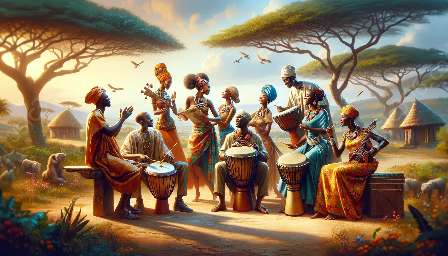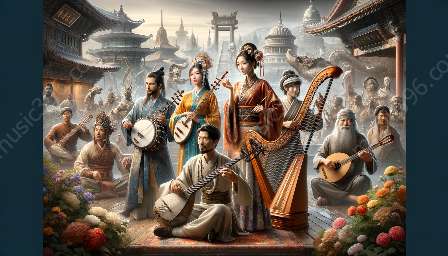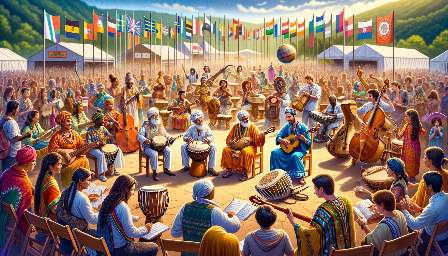South Asian music is steeped in diverse influences that have shaped its vibrant heritage. The confluence of external cultural forces has significantly impacted this musical tradition, giving rise to a rich tapestry of sound, rhythm, and expression. From ancient origins to modern interactions, South Asian music has evolved through a complex interplay of global dynamics, shaping its distinct identity within the broader landscape of world music.
Historical Context
The influence of external cultural forces on South Asian music can be traced back to antiquity. The region's rich history and strategic geographical location have made it a melting pot of diverse cultural exchanges. From the Indus Valley civilization to the arrival of Persian, Central Asian, and European influences, South Asian music has been shaped by a multitude of external elements. Trade routes, conquests, and migratory patterns have facilitated the cross-pollination of musical traditions, leading to a tapestry of sonic diversity.
One of the enduring legacies of this historical interplay is the assimilation of musical instruments, scales, and melodic structures from various external sources. The sitar, for example, is believed to have Persian origins, while the tabla, a fundamental percussion instrument in South Asian music, exhibits influences from Central Asian and Middle Eastern musical traditions. These cross-cultural exchanges have not only enriched the sonic palette of South Asian music but have also contributed to the global influence of its musical repertoire.
Religious and Ritualistic Influences
Religion and spirituality have played a profound role in shaping the musical expressions of South Asia. The region's diverse religious traditions, including Hinduism, Buddhism, Jainism, Islam, and Sikhism, have infused their distinct musical practices into the fabric of South Asian music. The devotional songs, bhajans, qawwalis, and hymns that emanate from these traditions reflect the deep spiritual connections that intertwine with various cultural influences.
Furthermore, the annual celebrations, festivals, and rituals within these religious traditions have contributed to the evolution of South Asian musical forms. Whether it's the exuberant rhythms of the Durga Puja in Bengal or the soul-stirring qawwalis during Sufi Urs celebrations, the interplay of religious and cultural forces has yielded a diverse spectrum of musical expressions that resonate with audiences across the globe.
Colonial Encounters and Global Interactions
The colonial era and subsequent global interactions have left an indelible mark on South Asian music. The encounters with European powers, particularly the British Raj, brought forth new musical sensibilities and instruments that intermingled with traditional South Asian music. The fusion of Western harmonies, orchestral arrangements, and compositional styles with indigenous melodies gave rise to a unique blend of musical expressions that continue to thrive in contemporary South Asian music.
Moreover, the advent of globalization and the interconnectedness of the modern world have further propelled the exchange of cultural influences. The proliferation of digital media, international collaborations, and diasporic communities has created a dynamic landscape for cross-cultural pollination. South Asian artists, both within the region and in the diaspora, have embraced diverse musical genres, including hip-hop, electronic music, and fusion styles, leading to a redefinition of traditional boundaries and a reimagining of South Asian musical identity in global contexts.
Impact on World Music
The influence of external cultural forces on South Asian music extends beyond its own borders, significantly impacting the broader realm of world music. The integration of diverse influences has contributed to the global recognition and appreciation of South Asian musical traditions. The evocative melodies, intricate rhythms, and improvisational prowess inherent in South Asian music have captivated audiences worldwide, shaping the sonic tapestry of world music.
Furthermore, collaborations between South Asian musicians and artists from different cultural backgrounds have led to an unprecedented fusion of musical styles, transcending geographical and cultural boundaries. This cross-pollination has not only enriched the global music scene but has also fostered a deeper understanding and appreciation of diverse cultural heritages.
Preserving Cultural Authenticity
Amidst the dynamic interplay of external cultural forces, the preservation of cultural authenticity remains a pertinent consideration in the evolution of South Asian music. While embracing new influences and modern expressions, it is essential to safeguard the intrinsic essence of traditional musical forms. Efforts to document, archive, and transmit ancestral musical knowledge are pivotal in ensuring the continuity of South Asian musical heritage for future generations.
Organizations, educational institutions, and passionate individuals are actively engaged in initiatives aimed at preserving traditional musical forms, instruments, and performance practices. By cultivating an environment that honors the roots of South Asian music while embracing innovative trajectories, the musical heritage of the region can thrive and continue to inspire global audiences.
Conclusion
The influence of external cultural forces on South Asian music is a testament to the dynamic evolution of this musical tradition. From historical exchanges to contemporary interactions, the interplay of diverse influences has forged a rich and multifaceted sonic identity that resonates with audiences worldwide. At the intersection of tradition and innovation, South Asian music continues to be a leading force in the global panorama of world music, reflecting the enduring impact of external cultural forces on musical heritage.










































